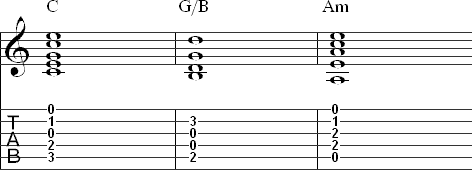What You Should Know
What You Will Learn
- How to spell major, minor, augmented, and diminished triads using intervals
- The difference between open and closed voicings
- What chord inversions are
Constructing Triads with Intervals
What is a Triad?
A triad is a three-note chord. There are four main kinds of triads: major, minor, augmented, and diminished. Each triad can be created by stacking intervals above a root. These intervals can be viewed in two ways:
- 1. As some kind of third and fifth above a root.
- 2. As two thirds stacked on top of each other. The thirds may be major or minor depending on the chord.
The specific combination of intervals determines the type of chord.
The Notes in a Triad
The root of a chord is the same as the letter name of the chord. For example, the root of an A minor chord is 'A'.
The other two notes in the chord are referred to as the third and fifth. The third is the next note in the chord after the root, assuming no notes are skipped. The fifth is the note right above the third. These labels can be applied regardless of the type of triad.
Major Chords
Major chords are constructed by adding a note a major third above a root and another note a perfect fifth above the root. Another way to look at it is that a minor third is stacked on top of a major third. A C major chord is shown below with the intervals labeled:

Common Major Chords
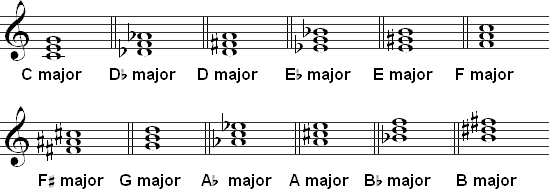
Minor Chords
A minor chord is a minor third and perfect fifth above a root. It can also be viewed as a major third on top of a minor third. A C minor chord is shown below with the intervals labeled:

Common Minor Chords
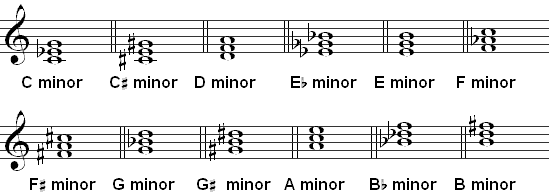
Augmented Chords
Augmented chords can be constructed by stacking two major thirds on top of each other. You can also look at it as a major third and an augmented fifth above a root.

Common Augmented Chords
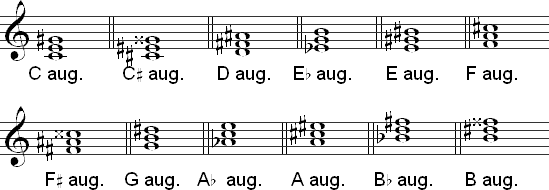
Diminished Chords
Diminished chords are created by stacking two minor thirds. Put another way, they are created by stacking a minor third and diminished fifth above a root.

Common Diminished Chords
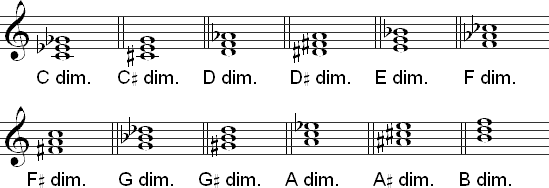
Intervals in Triads
The table below gives the intervals in each triad to make it easy to compare the different kinds of triads.
| Chord | bottom third | top third | fifth |
|---|---|---|---|
| major | major | minor | perfect |
| minor | minor | major | perfect |
| augmented | major | major | augmented |
| diminished | minor | minor | diminished |
Chord Voicing
A chord can be voiced in several different ways. Voicing is how the notes of a chord are arranged. Chords can be classified as either closed or open voicings.
Closed Voicings
In a closed voicing, the notes in a chord are close together, generally with no notes skipped. For example, the C major chord is made up of the notes C, E, and G. Playing C major like this is a closed voicing because the spacing between the notes wouldn't allow for any other chord tones to be included. A closed-voiced C major chord is shown below:

Open Voicings
Chords may also be open voiced. This means that the notes in the chord are spaced further apart and some notes in the chord will be skipped.
An open-voiced C major chord is shown below. The second measure shows the "missing" notes in red.

Open voicings usually sound better due to the spacing of the notes. Closed voicings should generally be avoided in the bass register because they sound muddy, although this sound may be desirable in some situations.
Chord Inversions
The bass note of a chord is the lowest note in the chord. It can be the root or any other note in the chord. A chord with the root in the bass is in root position. A chord is an inversion if any note other than the root is the lowest-pitched note.
First Inversion Chords
A chord is in first inversion if the third is in the bass. If you take a C major chord and put the E in the bass, the result is a first inversion C major chord:

Second Inversion Chords
A chord is in second inversion if the fifth is in the bass. For example, putting G in the bass of a C major chord gives you a C major chord in second inversion.

Slash Chords
A chord that is inverted may be indicated with a chord symbol like D/F#. The letter before the slash indicates the chord, in this case, a D major chord. The part after the slash indicates the note in the bass. It would be an F# for this chord. The chord is read as 'D slash F sharp.'
Practical Applications of Inversions
The most common reason for inverting chords is to create a smoother, more interesting bass line. Below is a G, D/F#, Em progression. This progression has been used in many songs, including Freebird. Note how the bass moves down by scale steps (i.e., G, F#, E).
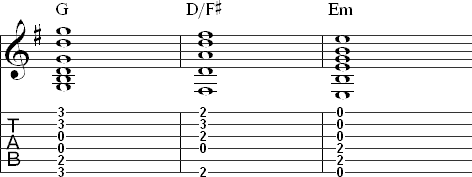
The progression C, G/B, Am is another common progression used in rock. This can be heard in Stairway to Heaven, Dust in the Wind, and many other songs. The bass moves down by scale steps here as well.
